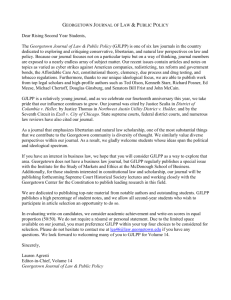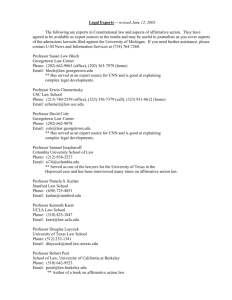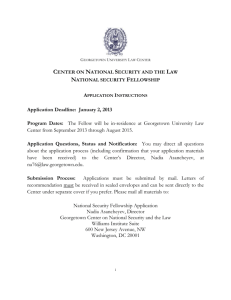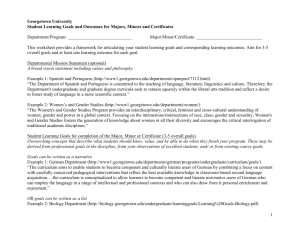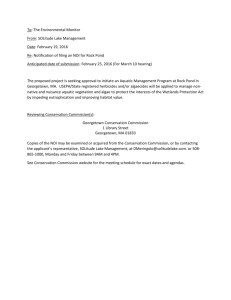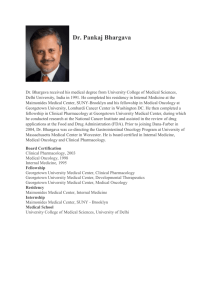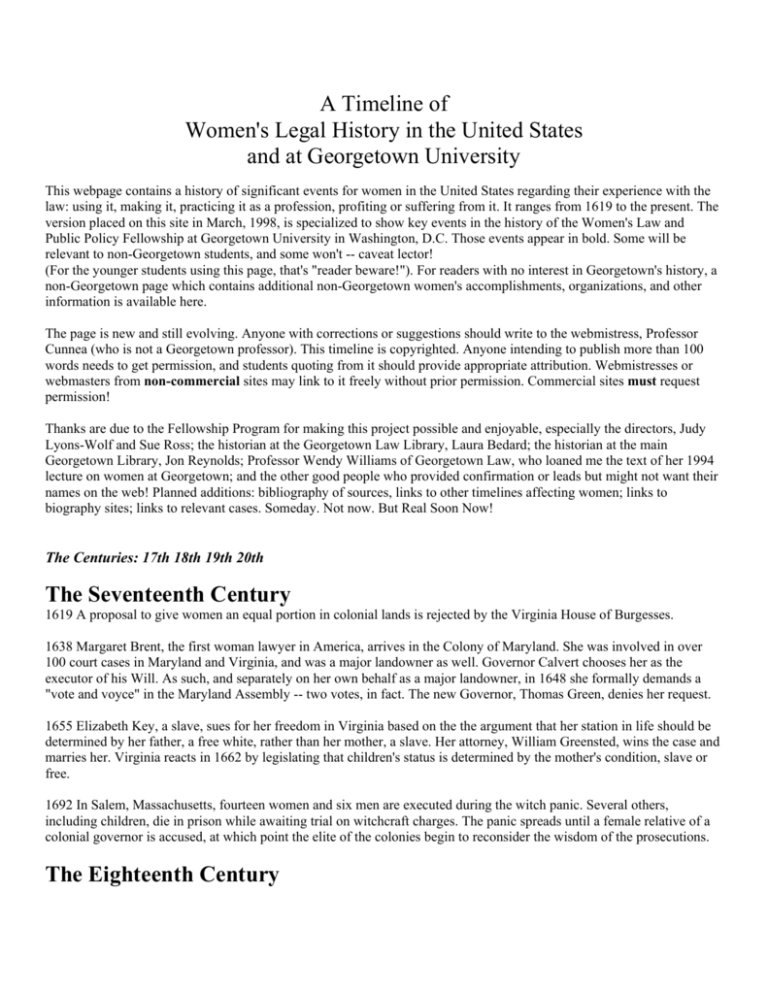
A Timeline of
Women's Legal History in the United States
and at Georgetown University
This webpage contains a history of significant events for women in the United States regarding their experience with the
law: using it, making it, practicing it as a profession, profiting or suffering from it. It ranges from 1619 to the present. The
version placed on this site in March, 1998, is specialized to show key events in the history of the Women's Law and
Public Policy Fellowship at Georgetown University in Washington, D.C. Those events appear in bold. Some will be
relevant to non-Georgetown students, and some won't -- caveat lector!
(For the younger students using this page, that's "reader beware!"). For readers with no interest in Georgetown's history, a
non-Georgetown page which contains additional non-Georgetown women's accomplishments, organizations, and other
information is available here.
The page is new and still evolving. Anyone with corrections or suggestions should write to the webmistress, Professor
Cunnea (who is not a Georgetown professor). This timeline is copyrighted. Anyone intending to publish more than 100
words needs to get permission, and students quoting from it should provide appropriate attribution. Webmistresses or
webmasters from non-commercial sites may link to it freely without prior permission. Commercial sites must request
permission!
Thanks are due to the Fellowship Program for making this project possible and enjoyable, especially the directors, Judy
Lyons-Wolf and Sue Ross; the historian at the Georgetown Law Library, Laura Bedard; the historian at the main
Georgetown Library, Jon Reynolds; Professor Wendy Williams of Georgetown Law, who loaned me the text of her 1994
lecture on women at Georgetown; and the other good people who provided confirmation or leads but might not want their
names on the web! Planned additions: bibliography of sources, links to other timelines affecting women; links to
biography sites; links to relevant cases. Someday. Not now. But Real Soon Now!
The Centuries: 17th 18th 19th 20th
The Seventeenth Century
1619 A proposal to give women an equal portion in colonial lands is rejected by the Virginia House of Burgesses.
1638 Margaret Brent, the first woman lawyer in America, arrives in the Colony of Maryland. She was involved in over
100 court cases in Maryland and Virginia, and was a major landowner as well. Governor Calvert chooses her as the
executor of his Will. As such, and separately on her own behalf as a major landowner, in 1648 she formally demands a
"vote and voyce" in the Maryland Assembly -- two votes, in fact. The new Governor, Thomas Green, denies her request.
1655 Elizabeth Key, a slave, sues for her freedom in Virginia based on the the argument that her station in life should be
determined by her father, a free white, rather than her mother, a slave. Her attorney, William Greensted, wins the case and
marries her. Virginia reacts in 1662 by legislating that children's status is determined by the mother's condition, slave or
free.
1692 In Salem, Massachusetts, fourteen women and six men are executed during the witch panic. Several others,
including children, die in prison while awaiting trial on witchcraft charges. The panic spreads until a female relative of a
colonial governor is accused, at which point the elite of the colonies begin to reconsider the wisdom of the prosecutions.
The Eighteenth Century
1745 In Pennsylvania, frontierswoman and poet Susanna Wright becomes a prothonotary of the colony, enhancing her
stature as a legal counselor to her mostly illiterate neighbors, for whom she prepares wills, deeds, indentures and other
contracts. She also serves as an arbitrator in property disputes.
1764 American patriot pamphleteer James Otis compares the submission of the modern citizenry to the colonial
agreements made by previous generations to the legal submission of women to men, and argues that both classes ought
have the right to make their own compacts: "Are not women born as free as men? Would it not be infamous to assert that
the ladies are all slaves by nature?"
1765 Jenny Slew, a mixed-race woman about 46 years old, sues as a spinster in Massachusetts after being
kidnapped and enslaved in 1762. Through counsel, she argues that because her mother was white, she is not
subject to enslavement. She loses at trial and wins on appeal, despite her opponent's claim that her past marriages to slave
men make her a femme covert with no right to sue in her own name at all, whether slave or free. Ironically, she may have
escaped the civil oblivion common to married women at that time due to a 1706 anti-miscegenation statue forbidding
interracial marriages. Future president John Adams observes one of the proceedings and notes it in his diary.
1775 Prior to publishing his famed pamphlet "Common Sense," Thomas Paine proposes women's rights in an
article for Pennsylvania Magazine.
1776 Abigail Adams, wife of future U.S. President John Adams, writes him an impassioned note: "[I]n the new
Code of Laws which I suppose it will be necessary for you to make I desire you would Remember the Ladies, and be
more generous and favourable to them than your ancestors. Do not put such unlimited power into the hands of the
Husbands. Remember all Men would be tyrants if they could. If perticular care and attention is not paid to the Ladies we
are determined to foment a Rebelion, and will not hold ourselves bound by any laws in which we have no voice, or
Representation." After a mocking response in which John calls her "saucy" and claims "[w]e know better than to repeal
our Masculine systems," Abigail answers, "I can not say that I think you very generous to the Ladies, for whilst you are
proclaiming peace and good will to Men, Emancipating all Nations, you insist upon retaining an absolute power over
Wives."
1781 Mum Bett, a slave 37 years old, wins her freedom based on the argument that the 1780 Massachusetts constitution
declares "all men are born free and equal." Although she does not represent herself in court, she provides her counsel with
the legal theory, the first time a state constitution is used to challenge slavery. After her success, she changes her name to
Elizabeth Freeman. Except for her co-petitioner, a man known as Brom, other Massachusetts slaves are not freed until
1783.
1787 Women, initially permitted to vote in some areas during the colonial period and early statehood, are systematically
disenfranchised in every state but one through a series of legislative acts beginning in 1777. New Jersey completes the ban
when woman suffrage is revoked there in 1807.
1789 Georgetown University is founded.
1797 Lucy Terry Prince of Vermont, born in Africa, enslaved in the U.S., and freed via purchase by her husband, appears
in a property dispute before the U.S. Supreme Court regarding some farmland. The future governor of Vermont, Isaac
Tichnor, is her attorney, but Prince presents the oral argument herself. She wins, and Justice Samuel Chase compliments
her skill. She is best known to modern historians as a poet rather than as the first woman and possibly the first AfricanAmerican to argue before the Supreme Court.
1869 Lemma Barkaloo becomes the first woman law student in the nation. She does not complete her degree at the Law
Department of Washington University in St. Louis, but chooses to take the Missouri bar after one year of study. She
passes, and begins practicing in 1870, just months before her death at approximately age 22 of typhoid fever.
1869 Elizabeth Cady Stanton and Susan B. Anthony found the National Woman Suffrage Association. Lucy Stone forms
the American Woman Suffrage Association.
1869 The Wyoming Territory grants suffrage to women, followed in 1870 by the Utah Territory. Colorado, in 1893, and
Idaho, in 1896, were the next jurisdictions to grant women the vote. No other states would do so until a flurry of five
Western states enacted woman suffrage between 1910 -- 1912.
1870 The Law Department of Georgetown University begins classes in the fall.
1870 Ada Kepley, the first woman to earn a formal law degree in the U.S., graduates with an LL.B. from Union
College of Law in Chicago, now known as Northwestern University.
1870 Esther McQuigg Morris becomes the first woman judge in the country when she is appointed justice of the peace in
a mining town in Wyoming. Her predecessor there resigned his position to protest woman suffrage in Wyoming, which
Morris had helped secure.
1871 Belva Ann Lockwood matriculates at the new National University Law School after being rejected by the law
schools at Georgetown University, Howard University, and Columbian College. The latter school becomes George
Washington University in 1904 by an Act of Congress, and absorbs National fifty years later. George Washington
University now honors the alumna its earliest incarnation rejected, putting Lockwood's statue on prominent
display in the law library since at least the 1970's to the present.
1872 Victoria Claflin Woodhull is the first woman to declare for the United States Presidency. She founds the Equal
Rights Party, with a platform based on principles of socialism and sexual and racial equality drafted in part by Belva
Lockwood. In addition to being female, Woodhull is only 34 at the time, and would not be the Constitutionally-required
35 until September of 1873. Due to the age issue, she and her running mate, Frederick Douglass, are denied placement on
the ballot.
1872 Arguing that the Fourteenth Amendment permits it, Susan B. Anthony attempts to vote in the presidential election in
Rochester, New York. She is arrested, convicted, and fined. Sojourner Truth attempts to vote in Grand Rapids, Michigan,
but is refused a ballot and sent away from the polling place. Victoria Woodhull had attempted to vote in a lesser election
in 1871, also without success.
1872 Charlotte Ray becomes the first woman admitted to the Bar in the District of Columbia, as well as the first AfricanAmerican woman to be a member of the formal bar anywhere in the U.S. She opens a solo practice in Washington
specializing in real estate law, but according to Kate Kane Rossi, another early woman attorney, "although a lawyer of
decided ability, on account of prejudice [Ray] was not able to obtain sufficient legal business and had to give up . . . active
practice." Ray remains involved in the suffrage cause and returns to her first career, teaching, in New York in 1879.
1873 In Bradwell v. Illinois, the U.S. Supreme Court holds that states may statutorily deny women the right to practice
law. In 1872, while the Bradwell case is pending, Illinois passes a bill drafted by Alta M. Hulett which provides that no
person can be excluded from any occupation, profession, or employment because of sex. Hulett, only 19, becomes Illinois'
first woman lawyer. Bradwell, still waiting on the U.S. Supreme Court decision, does not re-apply and is deeply
disappointed when the Court's decision comes down upholding the discriminatory interpretation of Illinois' previous law.
Bradwell is finally licensed in 1890, when the state supreme court, on its own motion, reconsiders her 1869 application
and grants the license nunc pro tunc, backdating its effect to the original date. The U.S. Supreme Court, acting on the
motion of hte the U.S. Attorney General, follows suit in 1892. Bradwell, already mortally ill with cancer at the time of
these gestures, dies in 1894. 1874 Journalist and suffragist Lillie Devereux Blake publishes Fettered For Life, a novel
dramatizing the legal disadvantages of American women. She lobbies Congress and state legislatures for woman suffrage,
education, and property rights.
1875 In Minor v. Happersett, the U.S. Supreme Court rules definitively that the Fourteenth Amendment's privileges and
immunities clause does not have the effect of extending suffrage to women.
1878 Known as the "Anthony Amendment," the Women's Suffrage Amendment is introduced in Congress, beginning four
decades of intense federal lobbying and conflict.
1879 The U.S. Supreme Court is compelled to admit Belva Ann Lockwood to its bar, after rejecting her 1876 application
on the grounds of "custom." Lockwood, who held the requisite lower court license from the District of Columbia, DC.,
obtained Congressional legislation early in 1879 establishing that women who practice law must have access to even the
highest court.
1879 In Strauder v. West Virginia, the U.S. Supreme Court holds that the Fourteenth Amendment forbids a state to bar
men from jury pools based on race or color, but "[i]t may confine the selection to males, to freeholders, to citizens, to
persons within certain ages, or to persons having educational qualifications. We do not believe the Fourteenth
Amendment was ever intended to prohibit this." In 1961, the Court still relies on this case to continue denying women the
right to serve on juries.
1880 Georgetown University admits two female students to the School of Medicine. They go on to graduate from
the Women's Medical College of Philadelphia. Jeannette Sumner and Annie Rice returned to Washington after
completing their medical education and established the first dispensary to serve women and children in poverty.
1884 Belva Ann Lockwood leads a revival of the dormant Equal Rights Party as part of her candidacy for U.S. President.
With running mate Marietta Snow, editor of The Women's Herald of Industry, Lockwood wins over 4,000 votes in six
states. Indiana unsuccessfully tries to switch its votes from Grover Cleveland to Lockwood, but is barred by a technicality.
The party flags again after Lockwood's 1888 run.
1886 The Equity Club is founded at the University of Michigan by Lettie Burlingame for women law students and law
alumnae, later expanding to include women attorneys from other schools. It is the first professional organization for
women lawyers, and circulates its newsletters to members nationwide. Burlingame, a suffragist, goes into private practice
and "so successful was she that she won every case entrusted to her" prior to her death from "la grippe" in 1890.
1892 Feminist economist Charlotte Perkins Gilman publishes the novella The Yellow Wall-Paper, a horrifying depiction
of how the medical and legal systems worked together to institutionalize or otherwise isolate ambitious women simply by
spousal fiat. Such women were often treated for "mental exhaustion" by being deprived of any "unwomanly" intellectual
stimulation whatsoever, including basic writing materials or the right to hear news or speak to friends.
1893 Belva Lockwood, grudgingly admitted to the Supreme Court bar in 1879, is denied the right to join the state bar of
Virginia. The U.S. Supreme Court, relying on the 1873 Bradwell decision, reaffirms that state bars may discriminate on
the basis of sex.
1893 The Queen Isabella Association is formed by women to promote women's accomplishments at the World's Fair in
Chicago. They select their name to reflect that Europeans would not have settled America without Isabella's sponsorship
of Columbus. As part of the Fair, its legal committee organizes the first nationwide meeting of women lawyers.
1897 Lutie A. Lytle, an African-American attorney, becomes the first woman law professor in the nation when she joins
the faculty of the Central Tennessee College of Law.
1898 Women found a law school to accommodate female students rejected from established schools due to their gender.
Ellen Spencer Mussy and Emma Gillett found the Washington College of Law in the District of Columbia, now the law
school of the American University.
The Twentieth Century
1904 Georgetown University creates its first program to routinely accept female students: the all-female School of
Nursing.
1908 The Portia Law School in Boston is created for women to attend classes in the evening. It does so well that a day
program is added in 1922. The program continues to flourish even after other area law schools begin admitting women,
and becomes the New England School of Law in 1969.
1911 American mountain climber Annie Smith Peck ascends Mount Coropuna in Peru at the age of 61, and unfurls a
banner reading "Votes for Women" at the summit.
1914 Margaret Sanger is indicted on obscenity charges for sending birth control information through the U.S. mails. She
flees the country, but returns in 1915. The charges are dropped, and in 1916 she founds the first U.S. birth control clinic in
Brooklyn, New York.
1916 Jeanette Pickering Rankin of Montana is elected the first woman member of the United States House of
Representatives.
1919 Barbara Armstrong becomes the first woman appointed to a tenure-track position at an accredited law
school when she joins the staff of the University of California at Berkeley.
1920 The Nineteenth Amendment is passed, guaranteeing women the right to vote in federal elections. It reads, "The right
of citizens of the United States to vote shall not be denied or abridged by the United States or by any State on account of
sex."
1922 Florence Ellinwood Allen of Ohio becomes the first woman elected to a state supreme court.
1923 The Equal Rights Amendment to the U.S. Constitution is introduced. Drafted by Alice Paul, the ERA is initially an
affirmative statement: "Men and women shall have equal rights throughout the United States and every place subject to its
jurisdiction." The version Congress passes in 1972 was a 1943 revision: "Equality of rights under the law shall not be
denied or abridged by the United States or by any State on account of sex." It falls three states short of ratification in 1982,
and is reintroduced in subsequent Congresses without passage.
1924 Federal suffrage is extended to Native Americans of both sexes by an act of Congress. For the first time, all women
in the United States except for the residents of the District of Columbia are guaranteed the right to vote in federal
elections. Women in Puerto Rico win suffrage in 1928.
1925 Two wives of former governors became the first women governors. Nellie Tayloe Ross of Wyoming serves a single
two-year term. Miriam A. Ferguson of Texas serves twice, 1925-27 and 1933-35.
1928 Genevieve Rose Cline of Ohio becomes the first woman to be a federal judge when she is appointed to the U.S.
Customs Court, where she goes on to serve for 25 years.
1932 Hattie Wyatt Caraway of Arkansas is appointed to the U.S. Senate in 1932, and in 1933 becomes the first woman
elected to that office.
1933 Frances Perkins becomes the first female Cabinet member in U.S. history, selected by President Franklin D.
Roosevelt to be Secretary of Labor.
1934 Florence Ellinwood Allen, formerly of the Ohio Supreme Court, is appointed by President Franklin D. Roosevelt to
be the first woman on the federal appellate bench. She is chosen to sit on the Sixth Circuit Court of Appeals.
1945 The United Nations Charter is signed, and provides that "the peoples of the United Nations . . . reaffirm faith in
fundamental human rights, in the dignity and worth of the human person, in the equal rights of men and women
. . . ."
1946 In U.S. v. Ballard, the U.S. Supreme Court holds that "[t]he systematic and intentional exclusion of women, like the
exclusion of a racial group, or an economic or social class, deprives the jury system of the broad base it was designed by
Congress to have in our democratic society . . . . The injury is not limited to the defendant -- there is injury to the jury
system, to the law as an institution, to the community at large, and to the democratic ideal reflected in the processes of our
courts." However, the Court limits this holding to gender bias in the selection of federal jurors from whatever pool of
jurors are qualified by state law; a state's right to keep women out of the pool entirely is not disturbed.
1946 The United Nations establishes the Commission on the Status of Women to protect women's rights and monitor their
status world-wide.
1948 Eleanor Roosevelt heads the United Nations Commission on Human Rights and obtains passage of the United
Nations Declaration of Human Rights, which provides that everyone is entitled to the Declaration's rights and freedoms
without "distinction of any kind, such as race [and] . . . sex. . . ." The Declaration also explicitly provides for the equality
of women and men in marriage: "Men and women of full age . . . are entitled to equal rights as to marriage, during
marriage, and at its dissolution."
1949 Margaret Chase Smith becomes the first woman elected to the U.S. Senate without previously being appointed to the
office.
1949 Burnita Shelton Matthews becomes the first woman on the federal trial bench when President Harry S. Truman
appoints her a district court judge.
1950's Georgetown opens all graduate and undergraduate programs except for the Georgetown College to female
students. Some of the graduate schools had begun to admit women in the 1940's, following World War II.
1951 Georgetown University Law Center enrolls its first eight female students. An African-American woman
whose name has not been recovered is admitted in 1951 but does not attend. The first women to graduate are Ruth
Marshall Paven, a transfer student from Harvard, in June of 1953 and Renee Grosshandler Baum, a member of
the original eight, in October, 1953. Another of the first eight women, Helen Elsie Steinbinder, graduates in 1954
and, in 1957, becomes the first woman named to the law faculty.
1953 Playwright and journalist Clare Booth Luce becomes the first woman to be a U.S. Ambassador to a major posting,
Italy.
1955 The arrest of Rosa Parks fuels a new wave of civil rights activism when she refuses to give up her seat on a public
bus to a white man in Montgomery, Alabama. Echoing the origin of the first wave of feminism in the abolition movement
of the Nineteenth Century, the modern civil rights movement for racial equality spurs the second wave of feminism to
seek broader gender equality.
1956 Helen Steinbinder, one of the first women admitted to Georgetown University Law Center, and Mabel Dole
Haden, an African-American attorney, receive the first LL.M. degrees granted by the Law Center to women. The
following year, Steinbinder begins her teaching career on the law faculty.
1960 A new student organization forms at the Georgetown University Law Center "to assist wives of new
students in settling into the community, to enable the students' wives to better assist their husbands in their
progress through law school and to prepare the wives for the role they will ultimately occupy in the community as
lawyers' wives." The group was variously known as The Law Students' Wives Society, the Student Wives' Club
and, most commonly as time went on, Law Wives.
1961 In Hoyt v. Florida, the U.S. Supreme Court holds that state laws which effectively exclude women from jury pools
are not invidious discrimination, but rather, are an "inoffensive" attempt to accommodate the "special responsibilities" of
women, and that women tried before the resulting all-male juries have no valid claims under the equal protection clause.
1963 The Equal Pay Act passes, requiring equal wages for women and men doing equal work. It is the first
federal law prohibiting sex discrimination.
1963 Betty Friedan publishes "The Feminine Mystique," a keystone of the modern women's rights movement.
1964 The Federal Civil Rights Act passes, including Title VII, which guarantees equal opportunity in employment. Title
VII is the statutory basis not only for equal opportunity and sex discrimination cases, but, as a subset of the latter, sexual
harassment cases as well. The Civil Rights Act creates the Equal Employment Opportunity Commission to enforce
workplace equality.
1965 In the U.S. Supreme Court case Griswold v. Connecticut, married couples are assured nationwide access to
contraception.
1967 In Loving v. Virginia, the U.S. Supreme Court strikes down state anti-miscegenation statutes, guaranteeing the
liberty to form traditional marriages without regard to race.
1969 Women students are admitted to the Georgetown College, completing the co-education of all aspects of
Georgetown University.
1970 A group of women law students begins meeting on women's issues at the Georgetown University Law Center.
In the fall of 1971, they formally become the Women's Rights Collective. In 1990, the group is re-named the
Women's Legal Alliance.
1970 Georgetown Law's first Women and the Law class is taught by Barbara Allen Babcock, following up on the
nation's first courses at NYU in the fall of 1969 and at Yale in the spring of 1970. George Washington University's
National Law Center initiates its Women and the Law class in the fall of 1970, simultaneous with Georgetown, and
taught by Gladys Kessler and Susan Deller Ross. In 1971, Eleanor Holmes Norton teaches the course at NYU Law
School, and Ann E. Freedman joins Babcock in teaching the course at Georgetown. In 1972, Judy Lyons Wolf and
Nancy Stanley teach it at George Washington University, and in 1973, Marna Tucker and Brooksley Born do so at
Georgetown.
1971 The Women's Legal Defense Fund is founded to advance women's rights, initially litigating through a
network of volunteer lawyers. With a grant from the Junior League of Washington to fund paid staff, Judith L.
Lichtman becomes the first executive director in 1974.
1972 The Women's Rights Project of the Center for Law and Social Policy is established under the direction of
Marcia D. Greenberger. Its mission is to provide legal representation on women's issues in the courts, in Congress,
and through public education.
1972 Eisenstadt v. Baird assures nationwide access to contraception regardless of marital status, fifty-six years after the
first birth control clinic is opened.
1972 Title IX of the Education Amendments Act passes, guaranteeing equal access to academic and athletic resources
regardless of gender.
1972 Congresswoman Shirley Chisholm, a candidate for president in the Democratic primary, becomes the first woman
and the first African-American to run for a place on the presidential ticket of a major party.
1973 Roe v. Wade establishes a nationwide right to abortion, with restrictions permissible at late stages of pregnancy.
1974 The Georgetown University Law Center's Law Wives student organization changes its name to Law Spouses.
1974 Sex-Based Discrimination, coauthored by Kenneth M. Davidson, Ruth Bader Ginsburg, and Herma Hill
Kaye, is published as the first law school casebook addressing the topic.
1974 The first shelter in the U.S. for battered women opens in St. Paul, Minnesota. By the mid-1990's, there are over
1,000 such shelters nationwide, but with very limited bedspace and funding. Facilities located in large cities report that
they may have to turn away as many as 70% of the women who seek temporary respite from violence in their own homes.
1974 Ella T. Grasso of Connecticut becomes the first woman to win a governorship without being the spouse of an earlier
governor.
1975 In Taylor v. Louisiana, the Supreme Court reverses its 1961 position about the Sixth Amendment rights of criminal
defendants, and now holds that exclusion of women from juries is impermissible. Women are a "distinctive group" and
"sufficiently numerous and distinct from men" that jury pools without them are a violation of a defendant's right to be
tried before a true cross-section of the community. "If it was ever the case that women were unqualified to sit on juries or
were so situated that none of them should be required to perform jury service,
that time has long since passed."
1975 Sex Discrimination and the Law, co-authored by Barbara Allen Babcock, Ann E. Freedman, Eleanor Holmes
Norton, and Susan Deller Ross, is published, providing a second casebook on the subject. The book evolved from
materials the authors used for the first Women and the Law classes at Georgetown, George Washington University, and
Yale.
1976 Julianna Zekan becomes the first female Student Bar Association President at the Georgetown University
Law Center.
1978 The Emergency Domestic Relations Project begins as part of the Women's Legal Defense Fund. The Project,
through manager Meshall Thomas, helps indigent victims of domestic violence gain legal protection from their
batterers. The Project provides counseling about the court system, negotiation services, volunteer attorney
referrals and training, legislative advocacy and community education.
1978 Wendy Webster Williams authors a comprehensive 1978 Supplement to Sex Discrimination and the Law textbook to
augment and update the earlier work.
1978 The Pregnancy Discrimination Act becomes federal law, recognizing that discrimination on the basis of pregnancy is
discrimination on the basis of sex. The PDA guarantees pregnant women who are capable of working the right to do so,
identical to employees with other, but similar, medical conditions. The Act also mandates that employers provide the
same benefits to women at any stage of pregnancy, delivery, or recovery from delivery when they are medically unable to
work as to all other employees with temporarily disabling conditions. It also forbids workplace discrimination against
women based on the mere possibility of pregnancy.
1979 The Convention on the Elimination of All Forms of Discrimination against Women is adopted by the U.N. General
Assembly, becoming effective in 1981. By 1998, 161 nations have joined CEDAW; the United States is not among them.
CEDAW and similar instruments of international law become the focus of International and Comparative Law on
the Rights of Women classes begun in 1991 at the Georgetown University Law Center by Naomi Cahn, Anne
Goldstein, and Susan Deller Ross.
1980 After lobbying by women students for a clinic focused on women's rights, the Georgetown University Law
Center begins its Employment Discrimination Clinic. Initially headed by Wendy Williams and Catherine Cronin,
and then in the spring semester by Wendy Williams and Laura Rayburn, the Clinic's initial caseload is comprised
of federal agency employment discrimination hearings. In 1982, it is renamed the Sex Discrimination Clinic, and is
taught by Laura Rayburn.
1981 In Rostker v. Goldberg, the U.S. Supreme Court holds that single-sex registration for the military draft is
constitutional. In the dissent, Justice Thurgood Marshall notes that the decision relies upon "ancient canards about the
proper role of women" and "categorically excludes women from a fundamental civil obligation."
1981 Sandra Day O'Connor, nominated by President Ronald Reagan, becomes the first woman appointed to the Supreme
Court.
1981 The Women's Rights Project of the Center for Law and Social Policy becomes the National Women's Law
Center, with Marcia D. Greenberger and Nancy Duff Campbell as co-presidents. 1982 Mississippi University for
Women v. Hogan establishes that, under the equal protection clause of the Fourteenth Amendment, public schools may
not discriminate on the basis of sex without "exceedingly persuasive justification."
1982 The Georgetown University School of Nursing, the first University school to welcome women, now becomes a
graduate program, offering a Master of Science in Nurse-Midwifery. By 1998, the graduate program at the nursing
school offers five graduate specialties.
1983 The Women's Law and Public Policy Fellowship Program is founded at Georgetown University Law Center.
The Fellowship begins its partnership with the Sex Discrimination Clinic under the leadership of Susan Deller
Ross, director of both programs. The Clinic's focus shifts from agency hearings to federal court litigation on
women workers' employment discrimination suits, equal access to credit, and pregnancy discrimination, and
begins to include research on public policy issues such as the Equal Rights Amendment.
1984 Congresswoman Geraldine Ferraro of New York is chosen as the vice-presidential candidate on the Democratic slate
by presidential candidate Walter M. Mondale. She is the first woman in U.S. history to be on the presidential ticket of a
major party.
1984 A new student club, Women in Law as a Second Career, forms at Georgetown. 1985 The Rita Charmatz
Davidson Fellowship is established at the Women's Law and Public Policy Fellowship Program to honor the first
woman appointed to Maryland's Court of Appeals, funding work on the rights of women in poverty.
1986 The U.S. Supreme Court holds in Meritor Savings Bank vs. Vinson that sexual harassment creating a hostile or
abusive work environment, even without economic loss for the person being harassed, is in violation of Title VII of the
Civil Rights Act of 1964. Sarah E. Burns, assistant director of the Georgetown Sex Discrimination Clinic,
participates in an amicus curiae brief in this, the Court's first sexual harassment case.
1988 Judy Lyons Wolf begins work as director of the Women's Law and Public Policy Fellowship Program. Naomi
Cahn becomes assistant director of the Georgetown Sex Discrimination Clinic.
1989 The Georgetown Sex Discrimination Clinic shifts its focus from federal sex discrimination litigation to local
court litigation on domestic violence cases, helping battered spouses obtain civil protection orders, and filing
contempt motions when orders are violated.
1989 Judith Areen becomes Dean of the Georgetown University Law Center, the first female Dean in its history
and one of only a handful of women law school deans in the nation.
1990 The Women's Law and Public Policy Fellowship provides its 50th year of attorney time to the women's public
interest community.
1991 In UAW v. Johnson Controls, the U.S. Supreme Court holds that "fetal protection policies" such as mandatory
sterilization for women or complete exclusion from certain jobs are illegal gender-based employment discrimination and
forbidden under Title VII of the 1964 Civil Rights Act. The Georgetown Sex Discrimination Clinic submits an amici
brief on behalf of women's groups supporting this result.
1991 The Emergency Domestic Relations Project becomes part of the Georgetown Sex Discrimination Clinic.
1992 In the aftermath of the contentious Clarence Thomas -- Anita Hill Supreme Court confirmation hearings of 1991,
1992 becomes known as the political "Year of the Woman," with women elected to federal, state, and local offices in
unprecedented numbers.
1993 A woman attorney moves into the White House -- as First Lady, when Hillary Rodham Clinton moves to
Washington at President Bill Clinton's inauguration.
1993 Janet Reno of Florida is appointed by President Bill Clinton to be the first woman U.S. Attorney General.
1993 Ruth Bader Ginsburg, nominated by President Bill Clinton, becomes the second woman appointed to the Supreme
Court.
1993 The Family & Medical Leave Act becomes law, based on the research and policy initiatives prepared by the
Women's Law and Public Policy Fellowship class of 1985-86. President Bill Clinton selects the FMLA to be the first
legislation signed in his presidency. President George Bush had twice vetoed similar bills.
1993 Georgetown opens a day care center for the children of staff and students at the Law Center's new Sarah and
Bernard Gewirz Student Center, 23 years after the women law students first requested this much-needed amenity.
1993 The Harriet R. Burg Fellowship is established at the Women's Law and Public Policy Fellowship Program.
Burg, a 1980 graduate of Antioch Law School and counsel to the District of Columbia's City Council's committee
on education, died of breast cancer in April of 1983. She had been a physical therapist in her first career, and had
done her law school internship at the Disability Rights and Education Defense Fund. The fellowship in her honor is
designated to address legal issues facing women with disabilities.
1993 The Sex Discrimination Clinic files an amicus brief in U.S. v. Dixon, the first U.S. Supreme Court case to
consider civil protection orders against domestic violence. Both private enforcement of such orders and public
criminal prosecution of the underlying behavior are upheld.
1993 The Fellowship begins the Leadership and Advocacy for Women in Africa program. Twenty African women
attorneys and judges study and work in Washington for sixteen months. Each obtains an LL.M. degree focused on
women's rights from Georgetown University Law Center and provides six months of work to public interest
organizations devoted to advocacy for women. The graduates return to advocate for women in their native
countries and network with one another throughout the continent. The first four graduates from the initial pilot
program return to Ghana and Uganda at the end of 1994, and the final four graduates return to Tanzania and
Uganda at the end of 1997.
1993 Deborah Epstein begins as Assistant Director of the Sex Discrimination Clinic.
1994 In J.E.B. v. Alabama, the U.S. Supreme Court holds that even peremptory challenges are impermissible if their
effect is to discriminate on the basis of gender when seating a jury panel. The Court at last affirms that the equal
protection rights of the potential jurors to serve, rather than the Sixth Amendment rights of the defendant to a fair trial, are
a sufficient justification for ending invidious discrimination against jurors due to gender: "When persons are excluded
from participation in our democratic processes solely because of race or gender, this promise of equality [under the law]
dims, and the integrity of our judicial system is jeopardized."
1994 Passage of the federal Violence Against Women Act creates penalties for interstate stalking and other gender-based
crime.
1995 The Women's Law and Public Policy Fellowship provides its 100th year of attorney time to the women's
public interest community.
1995 The American Bar Association, after 117 years, inaugurates its first woman president, Roberta Cooper Ramo.
Martha Barnett is the chair of the ABA House of Delegates.
1996 U.S. women sweep the Olympics, competing and winning in more sports than ever before. Their success is widely
attributed to the maturation of the promise of 1972's Title IX.
1996 In the "VMI case," U.S. v. Virginia, the U.S. Supreme Court rules that the Virginia Military Institute, a state
supported military academy previously limited to men, must admit women in order to cure its violation of the equal
protection clause of the Fourteenth Amendment, or cease to operate from tax funds. Tightening the "exceedingly
persuasive" standard of review, the Court holds that separate is not equal as regards the creation of a military program for
women at another school, and that categorization by sex "may not be used . . . to create or perpetuate the legal, social, and
economic inferiority of women." The Court explicitly holds that no government unit may "den[y] to women, simply
because they are women, full citizenship stature -- equal opportunity to aspire, achieve, participate in and contribute to
society based on their individual talents and capacities."
1996 The Emergency Domestic Relations Project helps initiate the D.C. Superior Court's Domestic Violence Intake
Center. The Project begins a new focus on assisting petitioners to file for civil protection order cases and
conducting safety planning.
1997 The Emergency Domestic Relations Project hires its second Domestic Violence Intake Counselor, Melba
Calderon.
1998 In Oncale v. Sundowner Offshore Services, the U.S. Supreme Court unanimously decides that same-sex harassment
in the workplace falls under the protection of Title VII of the 1964 Civil Rights Act, and holds the sexual orientation of
the harasser irrelevant.
1998 Georgetown University appoints Carolyn B. Robinowitz, M.D., Dean of the School of Medicine, the first
woman medical school dean in the University's history. With Elaine L. Larson, R.N., Ph.D., as Dean of the School
of Nursing since 1992, and Judith Areen, J.D., continuing as Dean of the Law Center, Georgetown University now
has women deans of three graduate programs.
1998 The Emergency Domestic Relations Project manager Meshall Thomas enters her twentieth year of service to
victims of domestic violence in the District of Columbia. More than 50,000 women have benefitted from her
assistance.
1998 The Women's Legal Defense Fund becomes the National Partnership for Women & Families, reflecting a new
priority on consumer education, quality health care, and workplace issues affecting women. Judith L. Lichtman,
who joined the Fund in 1974 as executive director and was named president in 1981, continues as president of the
National Partnership.
1998 The Fellowship Program and the Sex Discrimination Clinic continue their partnership as the Center for
Legal Advocacy for Women's Rights at Georgetown University Law Center, directed by Susan Deller Ross. Shortly
afterwards, the Center grows to three partners as the Clinic becomes two clinics: one on Domestic Violence
directed by Deborah Epstein, and the other on International Women's Human Rights directed by Ross.
1998 The Women's Law and Public Policy Fellowship Program graduates its 15th class, for a total of 133 advocates
for women's rights to date. There have been 113 domestic fellows, and twenty international, providing almost 125
attorney-years of service to the women's legal advocacy community. In the fall of 1998, nine domestic Fellows and
two Fellows from Africa will build on this record.
Copyright info: (c) 1998 LS d/b/a Professor Cunnea. All rights reserved. Remove NOSPAM from the email
form to reach the professor. For permissions, contact here via email, or, if no response in 48 hours, contact the
Women's Law & Public Policy Program at Georgetown University in Washington, DC via phone. To cite this
work (as students must, to avoid academic disciplinary action -- remember, your teachers can use the web just as
easily as you can!), contact Professor Cunnea for appropriate citation information. An alternative, if acceptable to
your instructor, is to use the format "Cunnea, Professor. [pseudonym of L.S., Esq.]" with the web address, the
date, and whatever other information your school requires. Professor Cunnea is the "nom du net" of an alumna of
the Women's Law & Public Policy Fellowship Program.


